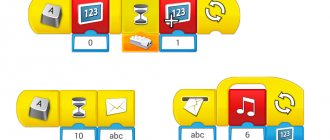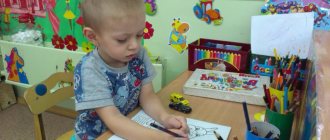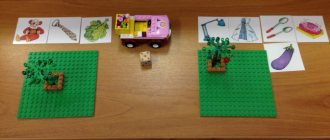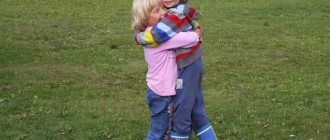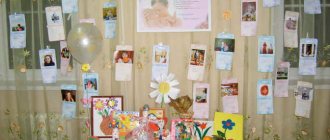Mathematical and science knowledge
Building activities using Lego constructors develop spatial thinking and awareness of proportions and shapes. While a child is building, his brain is thinking about which pieces will fit best, how to fit them together, and how big or small his building should be. Basic Lego pieces also teach children about fractions and division. By dividing a whole into halves and quarters, the child learns division without even realizing it. Knowledge in the field of physics is also gradually instilled and engineering skills are developed. When a child builds a tall building or a bridge, he thinks about three dimensions: balance, weight and the foundation of these structures.
Using different types of Lego constructors in working with children
Yana Levchuk
Using different types of Lego constructors in working with children
Using different types of Lego constructors in working with children.
Levchuk Yana Nikolaevna Municipal autonomous preschool educational institution No. 4, Armavir city.
Construction is a very interesting and exciting activity; it is closely connected with the sensory and intellectual development of a child. When working with preschoolers, taking into account their age characteristics, you can use different types of construction sets ; we will present to you our experience of working with different types of Lego construction .
.
Using the Lego constructor
when
working with preschool children, it helps to improve visual acuity, accuracy of color perception, tactile qualities, perception of the shape and dimensions of objects, space.
working on this topic since 2011. It attracted us because children can, with the help of an adult, and then independently, in a playful and very entertaining way for them, acquire the knowledge and skills that are defined in the program for each age.
The use of LEGO promotes :
1) the development of sensory concepts in children, since parts of different shapes are used , painted in primary colors;
2) development and improvement of higher mental functions: memory, attention, thinking, emphasis is placed on the development of such mental processes as analysis, synthesis, classification, generalization;
3) training the fingers of the hands, which is very important for the development of fine motor skills of the hand and will further help prepare the child’s hand for writing;
4) cohesion of the children's team, the formation of a feeling of sympathy for each other, because children learn to solve problems together, distribute roles, and explain to each other the importance of this constructive solution .
Constructive very closely related to the development of speech, since at first we lead the child to pronounce what he wants to do, what parts he will choose, why, the required number, size, etc. This joint pronunciation later helps the child himself determine the final the result of the work , be able to select all the necessary details and be able to explain why he designed it this way and not otherwise.
We began to use LEGO construction sets not only in joint and independent activities, but also as part of a lesson within the framework of the implementation of the “artistic activity”
with
children of the middle group . The prerequisites were that children, from a large number of games, most often turned to the construction set , and we often used this to test the children’s knowledge of basic colors and shapes; while playing, the children told what the object looked like and how it differed from others, what is its width, length, height.
Then we continued this work in the older group , when children 5-6 years old are already trying to solve constructive problems “by eye”
, they develop
imaginative thinking , they learn to imagine objects in different spatial positions, and mentally change their relative positions.
, parents were introduced to this area of work and talked about the types of Lego construction sets .
, with what educational tasks we plan to solve when
using it in the classroom and in joint activities.
With the help of our parents, we created a card index, stands with examples of buildings, and albums with illustrations of buildings. The development of Lego constructors was carried out sequentially from simple to complex. Classes on the development of constructive thinking are held for 25-30 minutes in the senior group; 30-35 minutes in the preparatory group.
Systematic classes with children for 3 years, from the middle to the preparatory group, as well as the active use of construction sets in independent activities showed that the children had a high level of development in constructive activities .
At first we simply got acquainted with the details of the construction set , how to attach two bricks, then we connected many bricks, and learned to work in a team . Subsequently, they brought in a sample of the building, learned to analyze the sample and correlate their actions with it “Gate”
,
"Fences"
.
Subsequently, we used the sample on the card “Building a house using a card
. The children analyzed the sample shown on the card, selected the necessary parts, and reproduced the construction. Complication through 2-3 topics - assembling a car using a card.
To , we use different types of Lego construction sets .
, since each of them corresponds to a certain age.
of constructor are applicable in the junior and middle groups :
• sets of growth building material from large “Soft”
;
• construction sets of the “Duplo” series;
• kits for designing vehicles and house structures;
• thematic sets - special equipment (firefighters, police cars, street cleaning vehicles, car lifts, etc.);
• Dasha the explorer;
• Zoo.
Kids enjoy building the simplest structures : paths, fences, bridges, gates, fences, cars, houses.
Children practice color recognition, counting to 5, and reinforce the concepts: “high - low”
,
“wide - narrow”
In the middle group, the basis for organizing work with Lego is a fairy tale . This is a preliminary familiarization with the work, and then designing its characters , creating models of familiar fairy tales, and also composing your own stories. At this age, children get acquainted with construction sets :
• LEGO DASTA - design by design;
• Single kits for constructing vehicles;
• Remote controlled transport.
The buildings are of a conditional nature; problems at the initial stage are associated with underdeveloped fine motor skills and their poor orientation in space. Subsequently, children can freely experiment with building materials.
In the senior and preparatory groups, construction of part of an object is added according to the teacher’s instructions, followed by completion according to one’s own plans and modeling of objects based on illustrations and drawings. Main topics - “Transport”
,
"Architecture"
.
A distinctive feature of transport models built by children of this age is their size and complexity. After the preliminary lesson - design according to plan - a lesson is conducted according to the conditions. For example, designing a two-story house with a porch and a balcony.
When making buildings, using verbal descriptions and visual actions, children learn to cope with complex stage-by-stage constructions.
We try to create problematic situations such that the child wants to build something himself to solve the problem.
The forms of organizing classes are very different : design according to given conditions, according to an image, according to a plan. Then comes designing from images .
The preparatory group is characterized by working with small construction equipment and complicating models. The main forms of organizing classes are work based on pictures depicting an object and according to a plan. Lesson topics: “ Construction according to a plan on the theme of summer holidays. “Modeling a butterfly from a picture”
,
" Spaceship Design
.
Thus, by using the construction set, children in the middle group develop independence; in the senior group, wide opportunities open up for constructive activities , which is facilitated by a solid assimilation of a variety of technical fundamentals and methods of design . In the preparatory group, classes are more complex in nature and experimentation. Moreover, these classes are not only interesting for the children, but also stimulate them to further work . The LEGO construction set allows you to experience the whole gamut of moods and positive emotions during the game.
The designer gives you the opportunity to experiment and create your own boundless world, to feel, on the one hand, an integral part of the team, and on the other, an unquestioning leader in the created situation.
But the main thing is that the game gives children self-confidence.
Judging by the release of the preparatory group, the children learned to analyze, their speech, creative imagination, and communication skills were developed, their memory improved, their attention became more stable, and the children learned to think logically.
Bibliography:
1. Levina, A. Developing perception (3-4 years)
/ A. Levina. —Publishing house OLMA-PRESS Exlibris, 2004
2. Kutsikova, L. V. Design and artistic work in kindergarten: Program and lesson notes . /L. V. Kutsakova. -M.: Sphere shopping center, 2009.-240 p.
3. Komarova, L. G. Building from LEGO (modeling of logical relationships and real-world objects using the LEGO constructor ) / L. G. Komarova. – M.: “LINK-PRESS”
, 2001.- 88 p.: ill.
of constructive creativity in preschoolers A. N. Davidchuk. – Ed. 2nd, add. M., "Enlightenment"
, 1976.
5. Brofman V. – The architectural school of Papa Carlo: a book for children and adults. – M.: “LINK-PRESS”
, 2001.-144p. ill.
General and physical development of the child
The most obvious benefit for a child's physical development when he constructs with Lego is the development of fine motor skills. Fine motor skills are responsible for the movement of small muscles. When a child manipulates Lego pieces, he develops coordination of small muscles in his fingers and hands. Developing the ability to follow instructions is also a benefit of building with Lego. Many Lego sets come with step-by-step instructions that the child must follow to complete the task.
The role of LEGO construction in a child’s development
Natalya Pasyuk
The role of LEGO construction in a child’s development
While playing with LEGO a child develops; in the process of construction, imagination is improved, fantasy develops, and children's technical creativity is stimulated.
Modern children live in an era of active informatization, computerization and robotics. Technical achievements are increasingly penetrating all spheres of human life and arousing children’s interest in modern technology. Thanks to LEGO, at the present stage it is possible to introduce children to the basics of the structure of technical objects already at preschool age.
It is known that children learn best through play. During the game, conditions are created that allow the child to independently build a system of relationships with peers and adults. In kindergarten, this method of teaching is traditionally one of the main ones.
LEGO is perhaps the most recognizable brand among children's toy manufacturers around the world. It was born back in 1932 thanks to its creator - a carpenter from a small town in Denmark - Ole Kirk Christiansen (he himself came up with the name for the brand, making it up from the first letters of the phrase “ LEg GОdt” - “play well” in Danish language Today there is not a single child and practically not a single adult who is not familiar with these wonderful play sets!
LEGO - construction allows you to introduce information technology into the educational process of a preschool institution, helping preschoolers master the elements of computer literacy, skills and abilities to work with modern technical means. The development of design abilities activates the child’s thought processes, promotes ingenuity and independence, initiative, and the desire to search for something new and original.
During LEGO construction, children:
• Develop fine motor skills of the hands;
• Learn to navigate space correctly and quickly;
• Gain mathematical knowledge about counting, shape, proportion, symmetry;
• Expand their understanding of the world around them;
• Develop attention, ability to concentrate, memory, thinking;
• Learn to imagine, fantasize, think creatively;
• Master the ability to mentally divide an object into its component parts and assemble a whole from the parts;
• They learn to communicate with each other, organize joint games, and respect their own and other people’s work.
What are the benefits of LEGO construction kits for children?
1. Scientists have concluded that LEGO promotes the development of motor skills and fine motor skills. To connect small parts with each other, the fingers will have to work hard, which will bring great benefits to the baby. Any design involves a variety of manual manipulations. A one-year-old baby learns to build a pyramid from blocks, training the coordination and dexterity of little fingers. A six-year-old child builds quite complex structures from parts of different shapes and sizes. All this requires active hand work. The development of fine motor skills is directly related to the development of thinking and speech.
2. With the help of the constructor, the child’s speech is improved. Let's take an ordinary set of parts from which you can build, for example, a house. Thanks to the participation of an adult, the child learns new words (shapes, names of building materials, parts) and their characteristics. He learns to correctly apply concepts in speech, compose sentences or a story.
3. LEGO perfectly develops structural and logical thinking, which is necessary for building three-dimensional structures and understanding the diagram attached to the construction set. Assembling parts into a whole requires complex mental activity. To get a logically correctly completed work, you need to think carefully. The colors in which the parts are painted are specially selected taking into account how children perceive the world.
4. By assembling a construction set, a child learns to be attentive and patient, to calmly experience failures and be persistent on the way to the goal, even if it is as seemingly modest as a small house made of bright details. In this way, he develops self-discipline and self-organization, which allows him to acquire qualities during the game that will be useful in the future. Only by carefully studying the instructions can you assemble the model correctly. Sometimes even a slight deviation from the task can ruin the entire plan. Often a child has to redo, correct, or correct an already assembled structure.
5. In addition, this game brings invaluable benefits to the creative thinking of the baby. It is necessary to constantly think about the next step, calculate all possible combinations and choose the most successful ones, analyze which step will be the best. The great advantage of the LEGO is the ability to assemble it to your liking, not limited to the forms proposed by the creators. The parts of different sets are combined with each other, which gives unlimited scope for imagination.
6. The designer develops imagination. LEGO construction kit parts you can build your own unique creation: a house for a bear, a garage for a car, an extraordinary bridge. Coming up with something new from the same type of cubes, bricks, logs is so interesting.
From one to 3 years. For this age group of children, they came up with a LEGO series called Duplo. The construction parts are larger to make them easier for kids to handle and to minimize the possibility of swallowing. Of course, in any case, parents need to be close to the child during the game.
From 3 to 7 years. These are ordinary LEGO construction sets with smaller parts from which you can build anything.
From 7 years and older. Sets in this category include a larger number of parts and are characterized by a high complexity of assembled objects. Some models of equipment even have a remote control, which is loved by many children.
Thinking skills
When a child builds with Legos, they are using their problem-solving skills. He must decide which parts to use in his work, sometimes through trial and error. Developing planning and organization skills are other benefits that make it worth visiting a Lego store and choosing the right building set for your child. Building with Lego requires a child to have a plan before they start building, even if it's a simple one. He must organize his thoughts according to the available Lego pieces to bring his idea to life.
